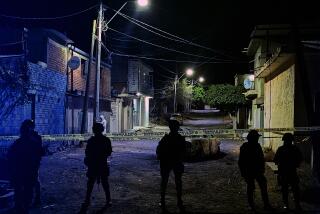Portable analog TV sets may be lost in transition
Barry Spadoni first bought a battery-powered TV after the Northridge earthquake in 1994, when his Chatsworth home was without electricity for 10 days. He later upgraded to a color model to stay on top of news during power outages -- and follow USC and UCLA football games from high in the stands.
“Having that little TV stuck in the drawer, where you just have to put in batteries . . . that’s very important if it’s a prolonged outage,” said Spadoni, a Wachovia financial advisor.
But come February, Spadoni’s hand-held TV and the millions of others in U.S. homes will face their own permanent outage.
Almost all the battery-powered televisions stashed in drawers, closets and garages in case of emergency will be rendered useless when broadcasters switch to digital-only signals.
And right now, there aren’t many options for replacing them.
Congress has mandated that all broadcast TV stations transmit only in digital beginning Feb. 18, making old analog sets obsolete. The federal government is offering each household two $40 coupons to buy converter boxes so those sets can pick up the new signals.
But nobody manufactures a battery-powered converter box. And the few battery-powered digital TV models on the market start at about $200 -- a costly option for replacing portable sets that have become increasingly inexpensive in recent years.
The loss of all those analog portable TVs removes an important way to communicate with the public during an emergency, said Keith Harrison, assistant administrator of the Los Angeles County Office of Emergency Management.
“When we get information out to people, we like to get it out by every means possible,” said Harrison, who also is president of the California Emergency Services Assn. “A lot more people watch TV than listen to AM radio.”
But the digital TV transition isn’t a major public safety issue because broadcast radio is still available to deliver important messages, he said.
“In preparedness kits, we tell people to have a battery-powered radio,” Harrison said. “While some people have battery-powered TV sets -- I know I have one -- not everyone does.”
Spadoni and others said there’s peace of mind in knowing they can watch TV when the power goes out, particularly in areas such as California, with its wildfires and earthquakes, or the hurricane-prone Southeast.
“We’ve been hearing a lot of concerns,” said Gary McNair, general manager of WECT-TV in Wilmington, N.C.
People in that coastal city are more attuned to the digital transition because broadcasters there will be turning off their analog signals permanently Sept. 8. In Wilmington, the test market for the Federal Communications Commission, the switch takes place in the middle of hurricane season.
McNair and general managers from three other Wilmington TV stations wrote to local retailers last month expressing “significant concern about the availability of portable digital television sets” and asking that more be stocked. WECT also formed a partnership with a local FM-radio station to simulcast its TV news coverage in the event of a hurricane to compensate for the loss of portable analog TVs, McNair said.
About 7% of households, or 8 million homes, owned hand-held TVs in 2006, according to the latest data from the Consumer Electronics Assn. With such a low figure, and more options for watching video on cellphones and laptop computers, it’s no surprise there are few battery-powered digital TVs on the market, said Tim Herbert, senior director of market research for the trade association.
Radio Shack is selling a battery-powered digital TV with a 7-inch screen for $199.99. And LCDDigital, a small manufacturer in Newport Beach, offers a 7-inch model for $249.99 and an 8.4-inch version for $349.99.
“They’ve been selling like crazy,” sales manager Peter Mamakos said. He said the company had sold thousands on its website, but he would not give any detailed figures.
Still, those prices are much higher than what many people paid for their portable analog sets, which start as low as $30 and often include other features, such as a radio or flashlight.
The National Telecommunications and Information Administration, which oversees the government’s converter box coupon program, said it had not certified any battery-powered boxes. The FCC is warning consumers on its digital TV website that analog portable TVs won’t work after Feb. 18 and that the only way to attach a converter box during an outage is to find an alternative power source.
One converter box maker, Winegard Co., of Burlington, Iowa, is trying to fill the void. It plans to offer a $20 to $25 battery pack for its two models sometime in August, said Grant Whipple, national sales manager for the company’s digital antennas and receivers.
“A lot of people have these portable TVs,” he said. “Those TVs are not going to work, and it’s something that was a little bit overlooked at first.”
Spadoni, the portable TV owner in Chatsworth, said he would probably buy a digital model to replace his faithful old Casio.
“Mine will just be trash,” he said.
--
-
(BEGIN TEXT OF INFOBOX)
Tuning in digitally when the power goes out
--
Here are some options for replacing an analog battery-powered TV, which won’t pick up broadcast signals after the nationwide digital conversion Feb. 18.
Buy a battery-powered digital TV
There are only a few models on the market, and they’re not cheap. Radio Shack sells a digital TV with a 7-inch screen for $199.99. LCDDigital of Newport Beach offers a 7-inch model for $249.99, and an 8.4-inch version for $349.99.
Advantages: The picture is clearer. You can replace the batteries when they run out.
Disadvantages: They’re expensive. You also may need an external antenna to pick up all the stations you get now.
--
Turn your laptop into a digital TV
Small devices with a digital tuner, such as the OnAirGT from AutumnWave, plug into the USB port of a laptop and turn the computer into a TV. They sell for $50 to $180.
Advantages: Assuming you already own a laptop, it’s less expensive than a portable digital TV.
Disadvantages: A laptop battery lasts only a couple of hours and requires electricity to recharge.
--
Use alternative power to run a digital-to-analog converter box
A power inverter, which enables you to run household electronics off your car battery or a rechargeable power pack, can fire up an electric converter box attached to your battery-powered analog TV. Inverters cost $30 to $150, while power packs run about $70 to $190.
Advantages: You don’t need to buy a new TV and can take advantage of the government converter box coupon program.
Disadvantages: This isn’t an option with some TVs, which don’t have the separate antenna input required for a converter box.
--
Get a TV package for your cellphone
Verizon, AT&T; and Sprint Nextel offer packages on certain smart phones that let you watch TV, including on-demand local TV news clips from many cities. Packages start at $10 to $15 a month if you already have phone service from the provider.
Advantages: You may not need to buy any new equipment.
Disadvantages: Of the major carriers, only Sprint offers live local TV (and so far only in Raleigh, N.C.), meaning most people must depend on local video clips or national network news and cable stations such as CNN for emergency information.
--
Source: Times research
More to Read
Start your day right
Sign up for Essential California for news, features and recommendations from the L.A. Times and beyond in your inbox six days a week.
You may occasionally receive promotional content from the Los Angeles Times.







